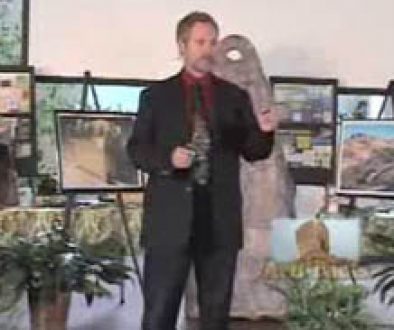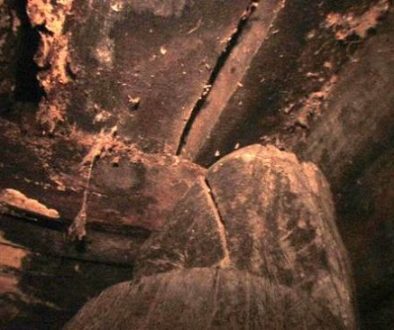Conference scholars reject ‘Jesus coffin’
A group of scholars is disputing the positive media coverage given a Jerusalem conference earlier this month on the so-called tomb of Jesus popularized last year by "Titanic" director James Cameron and Jewish investigative journalist and filmmaker Simcha Jacobovici, saying the majority of experts and academics in attendence either rejected the identification of the site excavated in 1980 as belonging to Jesus’ family or find the claim highly speculative.
As WND reported in February 2007, the Oscar-winning director’s film project, "The Lost Tomb of Jesus," claimed the discovery of 10 stone coffins in a Jerusalem suburb is actually the family crypt of Jesus of Nazareth.
The 90-minute film, made for the Discovery Channel, makes the case that Jesus had a son named Judah with Mary Magdalene.
Cameron and his director, Jacobovici, claimed also to have DNA evidence to back their story.
"People who believe in a physical ascension – that he took his body to heaven – those people will say, ‘Wait a minute,’" warned Jacobovici.
According to the filmmakers, 10 ossuaries, or stone boxes containing bones, found in the first century tomb are almost certain to hold the remains of Jesus, Mary Magdalene his wife, Judah their son and other family members.
One of the ossuaries is reportedly inscribed, "Jesus son of Joseph," another "Mariemene e Mara," which in some early Christian texts was believed to refer to Mary Magdalene, and another "Judah son of Jesus." DNA analysis of the bones reportedly showed Jesus and Mariemene were unrelated adults, leading to the conclusion they were husband and wife. Other ossuaries were inscribed with the names Mary, Mathew, and Jofa.
The news came a year after release of "The Da Vinci Code" movie, based on the best-selling novel of 2004 by Dan Brown, both of which also claimed Mary Magdalene was the wife of Jesus.
"This is archaeology," claims James Tabor, chairman of the religious studies department at the University of North Carolina, who is interviewed throughout the documentary. "We’ve got the casket. We’ve got the bones. I think we can say, in all probability, Jesus had this son, Judah, presumably through Mary Magdalene."
Cameron and Jacobovici cited statistical analysis that suggested finding the combination of related historical names in a first century crypt at 600 to 1.
Those claims were the subject of the "Third Princeton Theological Seminary Symposium on Jewish Views of the Afterlife and Burial Practices in Second Temple Judaism: Evaluating the Talpiot Tomb in Context," held Jan. 13-16, 2008, in Jerusalem. The conference was attended by some fifty international and Israeli scholars.
According to a posting on the Princeton Theological Seminary website, the consensus of the participants was against the tomb being related to Christianity’s founder.
"Unfortunately, many of the initial reports in the press following the symposium gave almost the exact opposite impression, stating, instead, that the conference proceedings gave credence to the identification of the Talpiot tomb with a putative family tomb of Jesus of Nazareth. As is abundantly clear from the statements to the contrary that have been issued since the symposium by many of the participants, such representations are patently false and blatantly misrepresent the spirit and scholarly content of the deliberations."
Several scholars issued a statement on the Duke University Religion Department’s website indicating their rejection of the filmmakers’ claims and disputing the press coverage.
Professor Mordechai Aviam, University of Rochester
Professor Ann Graham Brock, Iliff School of Theology, University of Denver
Professor F.W. Dobbs-Allsopp, Princeton Theological Seminary
Professor C.D. Elledge, Gustavus Adolphus College
Professor Shimon Gibson, University of North Carolina at Charlotte
Professor Rachel Hachlili, University of Haifa
Professor Amos Kloner, Bar-Ilan University
Professor Jodi Magness, University of North Carolina at Chapel Hill
Professor Lee McDonald, Arcadia Seminary
Professor Eric M. Meyers, Duke University
Professor Stephen Pfann, University of the Holy Land
Professor Jonathan Price, Tel Aviv University
Professor Christopher Rollston, Emmanuel School of Religion
Professor Alan F. Segal, Barnard College, Columbia University
Professor Choon-Leong Seow, Princeton Theological Seminary
Mr. Joe Zias, Science and Antiquity Group, Jerusalem
Dr. Boaz Zissu, Bar-Ilan University
(Story continues below)
The conference featured a challenge to the identification of "Mariemene" with Mary Magdalene, a crucial part of the statistical analysis behind Cameron’s and Jacobovici’s confidence.
Professor Stephen Pfann, of the University of the Holy Land in Jerusalem, said the inscription does not read "Mariemene e Mara" at all but instead "Mariame" and "kai Mara," suggesting the ossuary contained bones of two women, Mary and Martha. Further, other scholars of early church history dismissed the link between "Mariamene" and Mary Magdelene.
"A statistical analysis of the names engraved on the ossuaries leaves no doubt that the probability of the Talpiot tomb belonging to Jesus’ family is virtually nil if the Mariamene named on one of the ossuaries is not Mary Magdalene," wrote Duke University Professor Eric M. Meyers.
"Even the reading of the inscribed name as ‘Mariamene’ was contested by epigraphers at the conference," he wrote. "Furthermore, Mary Magdalene is not referred to by the Greek name Mariamene in any literary sources before the late second-third century AD. An expert panel of scholars on the subject of Mary in the early church dismissed out of hand the suggestion that Mary Magdalene was married to Jesus, and no traditions refer to a son of Jesus named Judah."
Myer also disputed the DNA claims of the filmmakers, citing a report by the head of the DNA laboratory at Hebrew University that concluded the sampling of the bone material was invalid and contaminated and could not be used to infer that "Jesus" and "Mariemene" were unrelated adults and, therefore, likely husband and wife.
"It was not even worth discussion. That should have closed the case," Myers told Christian Post.
The "smoking gun" at the conference, said Myers, was a surprise appearance by Ruth Gat, the widow of the archaeologist who excavated the tomb in 1980 and has since passed away.
Gat told the scholars her husband Yosef knew he had found "the burial tomb of Jesus Christ," but had "serious concerns and fears" over publicizing his discovery. Having been a child in Nazi-occupied Poland, he feared "a wave of anti-Semitism" because of his find.
Gat told the Jerusalem Post after her address her husband had been "staggered" by the discovery, and that he had discussed it with her "at the kitchen table."
Film director Jacobovici, who attended the symposium, said he "fell off the chair" when he heard her and claimed he had been vindicated by Gat’s statement.
But Gat’s claim was disputed by panelist Shimon Gibson, who was a young archeologist on the 1980 dig. He said Yosef never told him he believed the tomb was Jesus’.
Amos Kloner, former Jerusalem District archeologist, who wrote the excavation report from Gat’s minimal notes 16 years after the find, said the notion Gat believed he had found Jesus’ tomb was "absolutely not the case."
Further, noted Myers, Gat was a field archaelogist and did not have the epigraphic expertise to read the inscriptions.
According to Kloner, who called Jacobovici "a liar" at one session of the symposium and earlier branded the documentary "brain confusion," most of the bones found in the ossuaries 28 years ago were badly decomposed. Because of pressures from religious Jews, they were never subjected to anthropological tests and were transferred to the Religious Affairs Ministry for immediate reburial along with other remains found in construction projects and archaeological excavations. Their location is not known.






